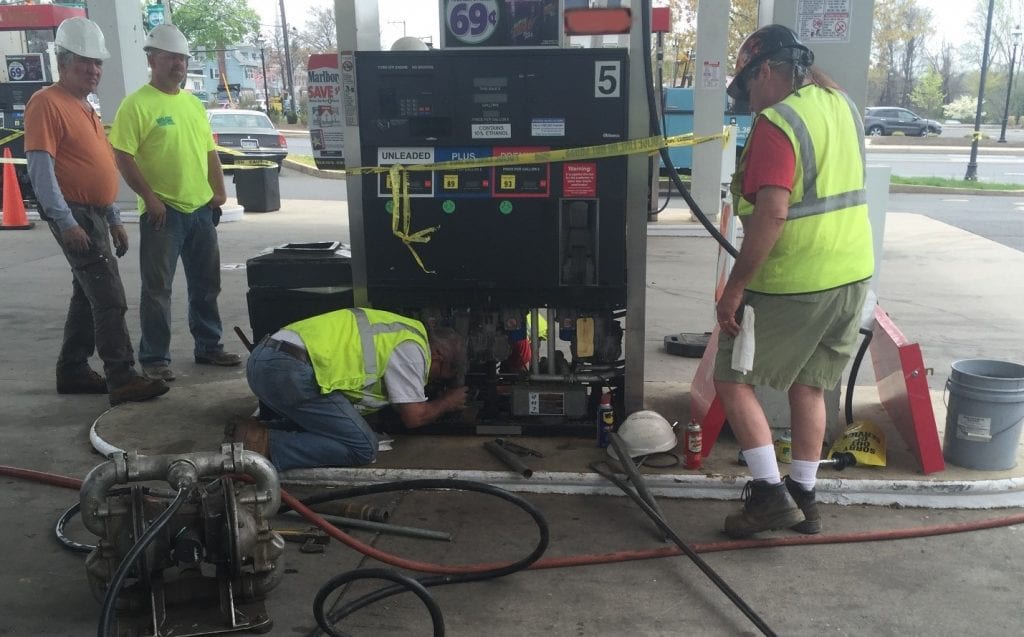
Are you acquiring a property that has an underground storage tank (UST)? Do you know if the UST is regulated? Do you know that you have certain responsibilities if you own a UST?
There are federal, state and local regulations that pertain to USTs. The EPA issued federal regulations, effective December 1988, that delegate UST regulatory authority to approved state programs. States are the primary implementers of the UST program and may have additional requirements and more stringent rules than the federal regulations. Local regulations may also impact some UST activities.
UST regulations are constantly changing and evolving. Keeping up with these changes is difficult and confusing. Hence, we end up answering a lot of questions. We compiled a list of the 10 most frequently asked UST questions my team has received and have listed them below.
1. What Types of USTs are Regulated?
Non-residential underground storage tanks that contain oil, petroleum and chemical liquids are regulated.
2.What Types of USTs are not Regulated?
The following types of tanks do not have to meet federal UST regulations:
- Farm and residential tanks of 1,100 gallons or less capacity holding motor fuel used for noncommercial purposes
- Tanks storing heating oil used on the premises where it is stored
- Tanks on or above the floor of underground areas such as basements
- Septic tanks and systems for collecting storm water and wastewater
- Flow-through process tanks
- Tanks of 110 gallons or less capacity
- Emergency spill and overfill tanks
However, some state or local implementing agencies may include these tank types in their UST regulations. Seek professional advice or check with your local regulator if you have questions about the requirements for your tank.
3. Are Heating Oil Tanks Regulated?
The installation and use of residential home heating oil tanks are not federally regulated. Heating oil tanks for commercial properties, in most instances, are also not regulated. However, some state or local agencies may include these tank types in their UST regulations.
Keep in mind that even if a tank is not regulated, any contamination resulting from the tank, including the clean-up of contamination is regulated. Any costs associated with maintenance and the eventual removal of heating oil USTs, including costs for remediation, should be considered when purchasing residential or commercial real estate.
4. What are the Responsibilities of a UST Owner/Operator?
Below are the requirements for the owners of federally regulated tanks:
- The tanks must be registered with the implementing agency (usually the state regulatory authority)
- Meet leak detection requirements
- Meet spill, overfill, and corrosion protection requirements
- Meet financial responsibility requirements
- Perform a site check and corrective action in response to leaks, spills and overfills
- Follow regulatory rules during installation of new tanks and closure of existing tanks
- Maintain records as required
- Have periodic checks performed on corrosion protection and leak detection systems
- Notify the implementing agency within 30 days of a UST system ownership change
- Notify the implementing agency at least 30 days before switching to a regulated substance containing greater than 10 percent ethanol, greater than 20 percent biodiesel, or any other regulated substance identified by the implementing agency and maintain records demonstrating the UST system meets the compatibility requirements
- Test or inspect following repairs to spill prevention equipment, overfill devices, and secondary containment areas
- Use secondarily contained tanks and piping when installing or replacing these components
- Use under-dispenser containment when installing new dispenser systems
- Have trained class A, class B, and class C operators
- Perform periodic testing of spill prevention equipment and containment sumps used for interstitial monitoring of piping
- Perform periodic testing of release detection equipment
- Perform periodic inspections of overfill equipment
- Perform periodic walkthrough inspections at the UST facility
- Perform release detection for emergency generator tanks
UST owners and operators should seek professional advice or contact their implementing agency to receive specific information on requirements for their tanks.
5. Do UST Owners Have to Submit Reports?
Tank owners are required to submit reports to the implementing agency on the following occasions:
- When a UST is installed, a notification form must be submitted to the implementing agency. This form provides information about the UST, including a certification of correct installation.
- Suspected releases must be reported to the implementing agency. State agencies have different reporting timeline requirements, in some cases in as few as two hours, and minimum spill threshold amounts that must be reported. If a release is confirmed, there will also be follow-up reporting requirements.
- The implementing agency must be notified 30 days before a UST is permanently closed.
- When ownership of a UST system has changed, a notification of ownership change form must be submitted to the implementing agency within 30 days of acquiring the UST system.
- The implementing agency must be notified at least 30 days before a switch to a regulated substance containing greater than 10 percent ethanol, greater than 20 percent biodiesel or any other regulated substance identified by the implementing agency.
- Owners of airport hydrant systems and field-constructed tanks must submit a one-time notification of existence for these UST systems using a notification form.
6. Are Above Ground Tanks Regulated?
Only those tanks that meet the definition of an underground storage tank (UST) system are covered by the UST regulations. Above ground storage tanks (ASTs) are subject to other federal, state or local regulations.
Most ASTs need to meet U.S. EPA’s Spill, Prevention, Control, and Countermeasure (SPCC) requirements (40 CFR, Part 112).
Some ASTs may need to meet additional state or local regulatory requirements that safeguard human health and the environment from potential threats posed by ASTs. You should check with your state agency in charge of oil pollution control activities for information on state and local requirements.
7. What Records Must UST Owners Keep?
UST owners have to keep records that can be provided to an inspector to prove the UST system meets current requirements. These records must be kept long enough to show the facility’s recent compliance status in the major areas listed below.
Below are the requirements for recordkeeping.
- Records of leak detection performance and maintenance:
- The last year’s monitoring results and the most recent tightness test
- Copies of performance claims provided by leak detection manufacturers
- Records of recent maintenance, repair and calibration of on-site leak detection equipment
- Records showing the required inspections and tests of the corrosion protection system, if applicable.
- Records of testing and inspections associated with operation and maintenance. Operation and maintenance activities include:
- Release detection equipment testing;
- Spill prevention equipment testing;
- Overfill prevention equipment inspections;
- containment sump testing; and
- Walk-through inspections.
- Records showing that a repaired or upgraded UST system was properly repaired or upgraded.
- For at least 3 years after closing a UST, the owner must keep records of the site assessment results required for permanent closure.
- Records that document the owner’s financial responsibility, as explained in EPA’s booklet, Dollars And Sense.
8. What Does a UST Owner have to do if there is a Spill or Release?
Below are the federal regulations:
If a release from an underground storage tank (UST) system is suspected, the owner or operator must report the release to the state or local implementing agency within 24 hours or another reasonable time period specified by the implementing agency.
Steps should also be taken immediately to stop the release and ensure that there is no threat to the safety of persons in the vicinity of the release.
It is not necessary to notify the implementing agency of aboveground spills or overfills of petroleum of less than 25 gallons (or another reasonable amount specified by the implementing agency) if the release can be contained and cleaned up within 24 hours. It is also not necessary to notify the implementing agency of a spill or overfill of a hazardous substance which results in a release to the environment that is less than its reportable quantity under CERCLA if it can be contained and cleaned up within 24 hours (for more information see 40 CFR 302.5 of CERCLA.)
Many states have much more stringent release reporting volume and timeline requirements. Every state has requirements for telephone notification and follow up written notification when a release has occurred. Seek professional advice or contact the state regulatory agency for regulations specific to your location.
9. How Do I Close a Tank?
Below are the federal requirements for permanent UST closure:
- Notify the implementing agency at least 30 days before you close your UST.
- Determine if contamination from your UST is present in the surrounding environment. If there is contamination, you may have to take corrective action. For at least 3 years, keep a record of the actions you take to determine if contamination is present at the site (or you can mail this record to your implementing agency).
- Either remove the UST from the ground or leave it in the ground. In both cases, the tank must be emptied and cleaned by removing all liquids, dangerous vapors, and accumulated sludge. These potentially very hazardous actions need to be carried out carefully by trained professionals who follow standard safety practices. If you leave the UST in the ground, have it filled with a harmless, chemically inactive solid, like sand, or close it in place in a manner approved by the implementing agency.
State requirements for UST closure are often more stringent than the federal regulations. Seek professional advice or contact the state regulatory agency for UST Closure Regulations specific to your location.
10. How Much Do Cleanups Cost?
The cost of cleanup depends on a variety of factors, including the extent of contamination and applicable state cleanup standards. According to the EPA, the average cleanup is estimated to cost $130,000. If only a small amount of soil needs to be removed or treated, cleanup costs may be as low as $10,000. However, costs to clean more extensive soil contamination may exceed $130,000. Corrective action for leaks that affect ground water typically cost from $100,000 to over $1 million, depending upon the extent of contamination.
Keep Up with the Regulations
EPA’s regulations concerning USTs are contained in 40 CFR Part 280, 40 CFR Part 281 and 40 CFR Parts 282.50-282.105. State regulations can be accessed through their individual websites.
UST systems and their associated regulations have evolved significantly over the last several years. Keeping up with the changes is a full-time job. If your UST questions were not answered, contact me or a member of my team.

